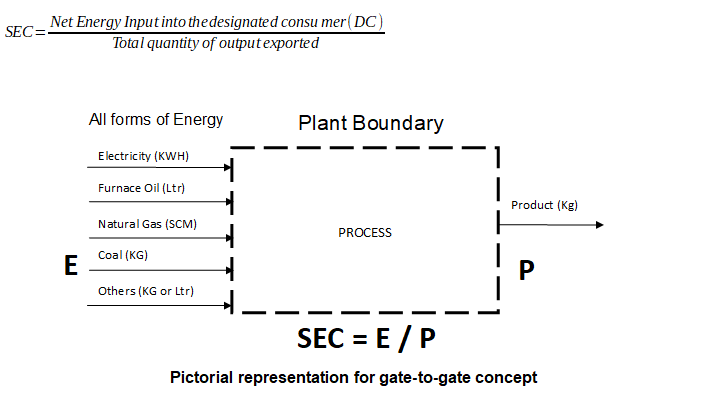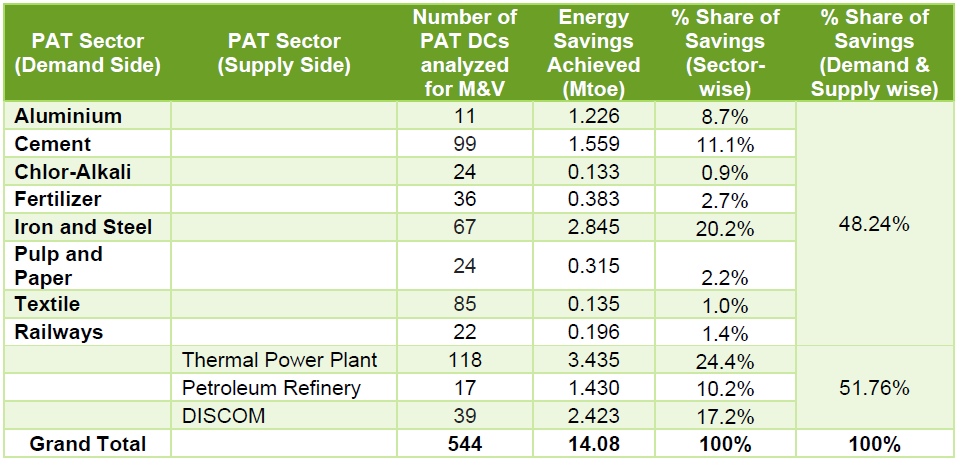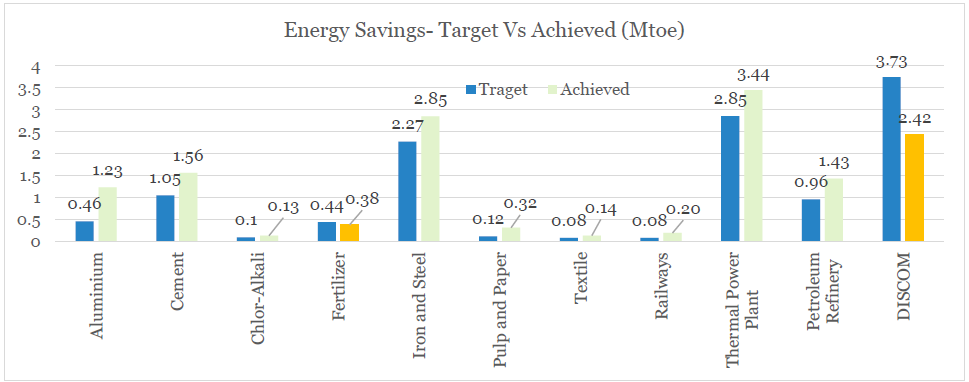Perform Achieve and Trade (PAT)
Perform, Achieve and Trade (PAT) is a regulatory instrument to reduce Specific Energy Consumption in energy intensive
industries, with an associated market based mechanism to enhance the cost effectiveness through certification of excess energy saving which can be traded.
PAT is a mechanism for improvements in energy efficiency of energy intensive industries. Specific high energy intensive industries are identified as Designated Consumers (DCs) within certain key sectors, who are required to appoint an energy manager, file energy consumption returns every year and conduct mandatory energy audits regularly. The key tasks in the PAT mechanism is to set the methodology for deciding the Specific Energy Consumption (SEC) norms for each designated consumers in the baseline year and in the target years, devise verification process for SEC, finding ways of issuing the Energy Savings Certificates, operationalization of the trading process for ESCerts in addition to the compliance and reconciliation process for ESCerts.
A brief description of the approach is as follows:
-
Specification of specific energy consumption (SEC) norm for each designated consumer in the baseline year and in the target year.
-
Verification of the SEC of each designated consumer in the baseline year and in the target year by an accredited verification agency.
-
Issuance of Energy Savings Certificates (ESCerts) to those designated consumers who exceed their target SEC reduction.
-
Trading of ESCerts with designated consumers who are unable to meet their target SEC reduction after three years.
-
Checking of compliance, and reconciliation of ESCerts at the end of the 3-year period. In case of non-compliance, a financial penalty is due.
SEC is calculated on a Gate-to-Gate concept. It refers to the calculation of specific energy consumption in the baseline year and projected specific energy consumption in the target year covering different forms of net energy going into the boundary of the designated consumers’ plant and the products leaving it over the relevant cycle.
The SEC of an industry on Gate-to-Gate concept is calculated with the formula: Specific energy consumption (SEC) which is equal to the Net energy input into the designated consumers’ boundary divided by the total quantity of output exported from the designated consumers’ boundary.

Perform, Achieve and Trade Cycle- I (2012-13 to 2014-15)
Perform Achieve and Trade in its first cycle was designed to reduce the specific energy consumption (SEC) i.e. energy used per unit of production of 478 industrial units in 8 sectors viz. Aluminum, Cement, Chlor- Alkali, Fertilizer, Iron & Steel, Paper & Pulp, Thermal Power Plant and Textile. Energy saving targets were given to these 478 industrial units called Designated Consumers (DCs) based on their current levels of energy efficiency, so that energy efficient units will have low target of percentage reduction, as compared to less energy efficient units which will have higher targets. The overall SEC reduction targets aimed to secure 4.05% reduction in the total energy consumption of these industries totaling to an energy saving of 6.686 Million Tonne of Oil Equivalent (MTOE). Units which were able to achieve SEC level that are lower than their targets could receive energy savings certificates (ESCerts) for their excess savings.

Summary of energy saving and emission reduction PAT Cycle I:-
PAT Cycle-I had completed in March, 2015 after which the scrutiny of the Performance Assessment Documents (PADs) submitted by the DCs was carried out by BEE. Implementation of PAT cycle –I resulted in energy saving of 8.67 MTOE translating into avoiding of about 31 million tonne of CO2 emissions
Trading of ESCerts:
Ministry of Power had issued about 38.25 lakh ESCerts to 306 Designated Consumers (DCs of PAT cycle –I) for excess energy saving and 110 DCs of PAT cycle –I were entitled to purchase about 14.25 lakh ESCerts to meet their shortfall to meet energy saving targets. Trading of ESCerts at Power Exchange had commenced in September,2017. The total volume of ESCerts traded was about 12.98 lakhs resulting into a business of about INR 100 crores.
Perform, Achieve and Trade Cycle-II
“Deepening” –identification of new DCs in existing sectors and “Widening” –inclusion of new sectors, was carried out by BEE before the commencement of the second cycle of PAT. Deepening study resulted into identification of 89 DCs new from the existing sectors of PAT. Widening study resulted into notification of three new sectors namely Refineries, Railways and DISCOMs under PAT scheme. Energy consumption targets were notified to 621 DCs from 11 energy intensive sectors (eight existing sectors and three new sectors). PAT Cycle II commenced from 1st April, 2016 and was completed on 31st March 2019. Implementation of PAT cycle -II has resulted into total energy savings of about 14.08 MTOE translating into avoiding of about 68 million tonne of CO2 emission
PAT Cycle II Energy Savings Achieved


Perform, Achieve and Trade Cycle III
The Parliamentary Standing Committee on Energy, Executive Committee on Climate Change under Prime Minister’s Office (PMO) and Group of Secretaries recommended notifying DCs under PAT scheme annually for accelerated coverage. Thus, PAT scheme is being implemented on a rolling cycle basis where new DCs/sectors are notified every year. Since a decision was taken to put PAT scheme under the rolling cycle from PAT-II onwards, PAT cycle-III was notified on 31st March, 2017. PAT cycle -III seeks to achieve and overall energy consumption reduction of 1.06 MTOE for which targets have been notified to 116 Designated Consumers from six sectors viz. Thermal Power Plant, Cement, Aluminium, Pulp & Paper, Iron & Steel and Textile. PAT Cycle –III was completed on 31st March 2020. From implementation of PAT cycle –III, energy savings of about 1.594 MTOE and corresponding CO2 reduction of 5.59 million tonne of CO2 emissions has been realized.
Perform, Achieve and Trade Cycle IV
The fourth cycle of PAT was notified on 28th March-2018. A total of 109 DCs with a total energy consumption reduction target of 0.6998 million tonnes of oil equivalent were notified. These DCs were from 8 sectors consisting of 6 existing sectors of PAT cycle -I and two new sectors (Petrochemicals & Buildings). Monitoring & Verification of DCs under PAT cycle –IV has been completed and is under scrutiny. .
Perform, Achieve and Trade Cycle V
PAT cycle –V had commenced with effect from 1st April 2019. Under PAT cycle –V, 110 DCs from the existing sectors of PAT i.e. Aluminum, Cement, Chlor-Alkali, Commercial Buildings (Hotels), Iron & Steel, Pulp & Paper, Textile and Thermal Power Plant were notified with a total energy savings target of 0.5130 (MTOE). Monitoring & Verification of DCs under PAT cycle –V has been completed and is under scrutiny.
Perform, Achieve and Trade Cycle –VI
PAT Cycle-VI had commenced with effect from 1st April 2020. Under PAT Cycle-VI, 135 DCs from six sectors, i.e. Cement, Commercial buildings (hotels), Iron and Steel, Petroleum Refinery, Pulp and Paper and Textiles, were been notified. With implementation of PAT cycle –VI, it is expected to achieve a total energy savings of 1.277 MTOE..
Perform, Achieve and Trade Cycle –VII (2022-23 to 2024-25)
PAT cycle –VII was notified for the period of FY 2022-23 to 2024-25 wherein 707 DCs have been notified with overall energy saving target of 8.485 MTOE in the following 9 Energy Intensive Sectors, i.e. Aluminium, Cement, Chlor-Alkali, Iron and Steel, Pulp and Paper, Textiles, Thermal Power Plant, Railways and DISCOM.
Details of total
number of DCs notified under various PAT Cycles is mentioned in the table below:
|
FY 12-15 |
FY 16-19 |
FY 17-20 |
FY 18-22 |
FY 19-22 |
FY 20-23 |
FY 22-25 |
||
|
Aluminium |
10 |
12 |
1 |
- |
1 |
- |
12 |
14 |
|
Cement |
85 |
111 |
14 |
1 |
12 |
37 |
120 |
175 |
|
Chlor- Alkali |
22 |
24 |
- |
2 |
2 |
- |
24 |
28 |
|
Fertilizer |
29 |
37 |
- |
- |
- |
- |
0 |
37 |
|
Iron & Steel |
67 |
71 |
29 |
35 |
23 |
5 |
134 |
204 |
|
Paper & Pulp |
31 |
29 |
1 |
2 |
8 |
2 |
24 |
48 |
|
Textile |
90 |
99 |
34 |
7 |
16 |
7 |
120 |
168 |
|
Thermal Power Plant |
144 |
154 |
37 |
17 |
17 |
- |
152 |
239 |
|
Refinery |
- |
18 |
- |
- |
- |
20 |
0 |
20 |
|
Railways |
- |
22 |
- |
- |
- |
- |
26 |
26 |
|
DISCOMs |
- |
44 |
- |
- |
- |
- |
95 |
96 |
|
Petrochemical |
- |
- |
- |
8 |
- |
- |
0 |
8 |
|
Buildings |
- |
- |
- |
37 |
31 |
64 |
0 |
133 |
|
Total |
478 |
621 |
116 |
109 |
110 |
135 |
707 |
1196 |





